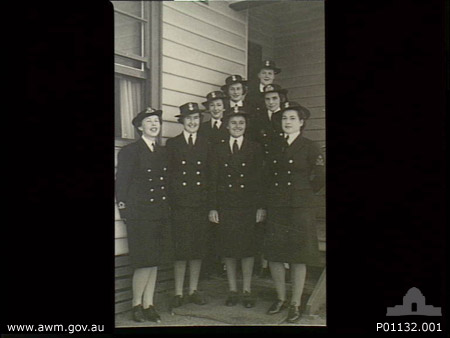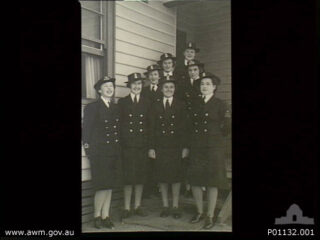- Entry type: Person
- Entry ID: AWE0468
Stevens, Marion
(1920 – 2015)
- Born 4 May 1920, Tamworth, New South Wales, Australia
- Died 26 August 2015
- Occupation Servicewoman
Summary
In 1941 Marion Stevens was one of the first 14 women to join the Royal Australian Navy. After two years at Harman she was transferred to Molongo and later to Cerberus for the Officer Training Course and then returned to Harman. After the war, with her beautiful singing voice, she joined the Gilbert and Sullivan Company and toured with them for two years. When the WRANS were reformed she was recalled and transferred back to HMAS Harman as Second Officer. Stevens stayed until 1956. On retirement she joined Paton and Baldwins. At HMAS Harman a street called ‘Marion Stevens’ honours the work she did there during the war. [1] Steven’s achievements were acknowledged with the renaming of the HMAS Harman Wardroom Dining Room in her honour.
Details
Marion Stevens WR5 – Women’s Royal Australian Naval Service, writes:
In 1939 I joined the W.E.S.C. (Women’s Emergency Signalling Corps) run by Mrs F V McKenzie, and learned Morse Code and signalling (Semaphore) etc. In 1941 I joined the Australian Navy as one of the first 14 women in the Service. I was No. WR 5, and went to H.M.A Naval Wireless Station Harman (later HMAS Harman) near Canberra. Our first problem was that all the men saluted us. We asked the Commanding Officer (C.O.) to get the men to regard us as ratings not women. This was the beginning of the WRANS Rules and Regulations. Our uniforms did not arrive for months so we had to continue to wear our green WESC’s uniforms. We were all under the Crimes Act so could only freely discuss our work in the W/T Office. I did a Stat. Dec. covering the period around the sinking of the HMAS Sydney and sent a copy to the Defence Department in Canberra and also to the Archives in Canberra. I was made the first Chief Petty Officer in 1943 and was put in charge of H.M.A. Naval W/T Station Molonglo, a few miles across country from HMAS Harman. Molonglo did all the high-speed operating with England – Whitehall GYCm, Canada Esquimalt CKL, Colombo Fort GZH and New Zealand – Waiouru ZLO. We handled all the traffic for the British Fleet when it came out to Australia at the end of the war in Europe and we got a signal complimenting us on our work by Admiral Bruce Frazer RN. It (Molonglo) was the only W/T station run completely by WRANS with an Army Guard. In 1944 the C.O. and I went to Mt. Stromlo Observatory to see the Director, Dr. Wooley. He needed some details from overseas circuits to help with Ionospheric Predictions. At the end of the war in Europe I was the Instructor for the RN Tel. Ratings sent out from England when the war was over in Europe.
When I left the Navy I studied singing at the Sydney Conservatorium and then joined J C Williamsons Gilbert and Sullivan Opera Company and toured Australia and New Zealand for a couple of years.
I then rejoined the Australian Navy as a Second Officer, did a further commission and was in charge of a Signit ‘Y’ Station. I was the WRAN Officer sent to England, with two ratings for the Coronation of our present Queen. While in England I visited Whitehall W/T a few times and met a P.O.Tel who said he worked Radio Belconnen during the war and they were the best station they worked and never let Whitehall down. I was asked to transfer from Communications to Administration and remain in the Navy, but I declined the offer and left the Navy at the end of my four year commission.
I worked at Patons and Baldwins in charge of their Demonstration Department. I did a little designing. We had eight Demonstrators and organized Parades and Displays throughout New South Wales and Queensland. At night I studied Gemmology and got my FGAA. I taught at Gemmology House for a few years. I toured Diamond Mines in South Africa and an alluvial Diamond Mine in South West Africa, and then did an Animal Safari through Kenya and Tanzania staying at Treetops. The next year I visited gem areas of Sri Lanka, India, Nepal, Burma and Thailand. I remained at Patons for 25 years and then went to a city jeweller to make use of my Gemmological knowledge.
I now live in a Retirement Village and have done oil paintings and 65 tapestry chairs and pictures etc. and helped the Parliamentary Committee who were investigating the sinking of the HMAS Sydney on the 19 November 1941 by the German Raider Kormoran which also sank. I have done a lot of travel both in Australia and worldwide.
[1] Ships Belles p. 67-69
Archival resources
-
National Archives of Australia, National Office, Canberra
- STEVENS MARION : Service Number - WR/5 : Date of birth - 04 May 1920 : Place of birth - TAMWORTH NSW : Place of enlistment - SYDNEY : Next of Kin - STEVENS EUGENE
- STEVENS MARION : Service Number - WR5 : Date of birth - 04 May 1920 : Place of birth - Unknown : Place of enlistment - Unknown : Next of Kin - STEVENS E
Digital resources
Published resources
-
Resource Section
- STEVENS, MARION, Department of Veterans' Affairs, 2002, http://www.ww2roll.gov.au/script/veteran.asp?ServiceID=N&VeteranID=1170934
- STEVENS, MARION, Department of Veterans' Affairs, 2002, http://www.ww2roll.gov.au/script/veteran.asp?ServiceID=N&VeteranID=1196416
- Book
- Resource
